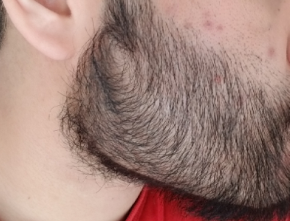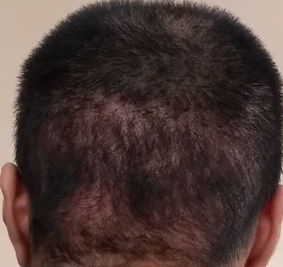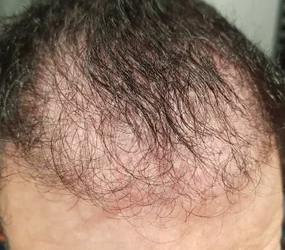Yes, there is a reduction of hair in the donor area which is clearly helped by letting your hair grow out longer as you did on the picture on the right. If this still bothers you, you can have Scalp Micropigmentation (click here) will make it look like you never had the donor area harvested
Dr. Rassman, I implore you to avoid making slanderous comments about another physician’s character online. Go ahead and criticize the result – but calling a physician ‘immoral’ is unprofessional, at best.
I have been outspoken for many years, at meetings and in written comments, even in published materials. Many years ago, I was heavily criticized when I told hundreds of doctor at a meeting about a surgery that was commonly done that I though was inappropriate and deforming. The result of those comments resulted in almost all of the doctors in litigious countries, to stop doing this particular surgery. Donald Trump was a victim of that surgery and from what I heard through medical channels, he was very, very angry with his results and lives with those results today (as everyone can see).
Some doctors must be held accountable and when a person comes to see me and they tell me their ‘horror story’ I do my best to make sure others are aware of their story so that the few rotten applies in our profession will learn that they can be held accountable. I called this doctor immoral because he lied to the patient, promised something he didn’t deliver (a partly failed transplant) and significantly overcharged him. Like any other trade or profession, not everyone behaves morally. When they cause harm, there is always the court system to protect the innocent. I have occasionally volunteered as an expert witness in such cases. As you should note, I did not name the doctor involved.
For this man’s doctor, each patient was about money, i.e. how much money he could extract from every patient. Many young men fall victims to such doctor behavior as this man did. The doctor told him that the 3000 grafts he was going to perform would not produce any scarring. This man only had a very small bald area in the two corners which could have easily be fixed with 500 grafts per side, but the doctor and his salesman told him he needed 3000 grafts (at least 2000 which were unnecessary). Many of the grafts in these two balding corners did not grow, but the doctor got his money, nevertheless, a lot of money. After the grafts grew in poorly, this man was stuck with white scars from the FUE which he was told was a scarless surgery (not true). He wanted to keep his hair short, but because of the scars, he could not. There are many things about this man’s terrible experience that bothers me: (1) he could not really afford the $30,000 he spent on these grafts (he overpaid even for a good surgery and went into debt to get it), (2) the grafts were taken from his neck area (which is not permanent hair so some of the hair that did grow will not be permanent), (3) he was lied to by the doctor and the doctor’s slick salesman about almost everything relating to the transplant and oversold the number of grafts by 2000 grafts, and (4) he was left with bothersome scars (which I fixed for him with Scalp Micropigmentation) at still another cost he should not have had. The first four pictures are of his ‘scarless surgery’. The second pictures were taken after we repaired the scars with Scalp Micropigmentation.
The patient does have recourse against this doctors by: (1) demanding his money back with the threat of legal action if he does not get his money back (I often help such patients find an attorney who will help them), (2) he can take his complaint to the medical board (in California, the medical boards license the doctors and they must investigate all such claims and if the doctor is found guilty, he could lose his license to practice medicine). I always agree to supply testimony for such patients to assist them to get justice for complaints either in court or for the medical boards. I am even more angry than this man because these slimy doctors give my profession a bad name and harm people. Doctors should be above this type of behavior.
 This is an important book to read for those of you who are experiencing hair loss from a man who went through it. He discusses the pitfalls in the commercial side of the hair transplant business which you should all know about. John Vincent has offered our readers a free copy of the book by emailing him here:
This is an important book to read for those of you who are experiencing hair loss from a man who went through it. He discusses the pitfalls in the commercial side of the hair transplant business which you should all know about. John Vincent has offered our readers a free copy of the book by emailing him here:
| John Vincent <john@hairconsultant.com> |
It is too early to tell much. Your hairline is still in its juvenile position (because it approximates the highest crease of the furrowed brow) and I would expect that it would rise about 1/4 inch from where it is. Maybe what you are seeing on the right side is the first step in this process. If I were to see you, I would look to see if you had miniaturization in the frontal area, which would indicate changes coming.
I don’t believe that finasteride will impact brain development.
This is a failure of the transplant unless your surgeon placed far less than the 2200 grafts you reported. I would go back to have a frank discussion with your surgeon as you paid good money to have this done. The most frequent reasons for hair transplant failure, is some technical glitch or lack of experience by the surgeon and/or his team!
I addressed the question by suggesting that they check me out in the medical board offices of the States of California, New York and Florida where I am licensed. I thought I would share some of my recent awards with you in case you have any doubt. These include Best Doctor in the United State for hair transplantation by Castle Connolly (see here:https://www.castleconnolly.com/about/NomProcess.cfm ) for 10+ consecutive years, the Golden Follicle Award (see here: https://newhair.com/wp-content/uploads/2018/11/nhi-newsletter-2005.pdf), Two Life Time Achievement Awards presented in 2019 (by South American and European Societies).
I guess the answer to the question is that I must be licensed to practice medicine or I am a hell of an impostor.
I give the patient a surgical sponge that has no soap in it. The patient then wets his recipient area with softly running water. Any good shampoo can be used with the sponge. Put shampoo into a small bowl of water and then using the sponge, make a lot of suds so that it fills with shampoo. Then with a rolling motion (back to front, not rubbing), press the sponge on the recipient sites so the soap from inside the sponge squirts on the grafts as you press on the sponge holding a mild pressure on the grafts. A back to front rolling motion is best. This process is repeated until all of the crusts are off provided that it is started the day after the surgery. If there are some persistent scabs, use a Q-tip dipped into the bowl. Roll the a-tip over the scab until it comes off. The cotton in the Q-tip will pull off the scabs as you roll in over the scab. If you wait too long, the crusting (scabbing) gets fixed to the scalp and then there is a new problem, how to get off the crusts that have been there for a few days as these grafts are then fixed to the scalp. If you pull them off at this point in time, the grafts will come out. Read this article: https://newhair.com/wp-content/uploads/2018/11/mp-2006-graft-anchoring.pdf
When you say pencil size from the 1980w, you mean the shaft of a pencil? Presumably this little bit of tissue had several follicles? When I heard the term in the past I thought they were little wigs you wore in the receded area!
A hollow drill was used in the back of the head that cored out a pencil size plug of hair. These were placed in the front in rows. Only a quarter of an area was covered with each of four surgeries with the idea that when eventually filled in, the four quarter patterns would cover the balding areas. Unfortunately, the idea was flawed, because after the plug was put into the scalp, it would contract squeezing the plug to a very high hair density. The the central part, would die off so that the plug looked like donuts. With these high density plugs surrounding a hole in the center, the unfortunate victims has a pattern of hair plugs that anyone could see within 20 feet. I, personally, can’t believe that the public accepted this result, but they did, maybe because they felt that a dolls head of hair was better than a bald head of no hair.
Before one gets a hair transplant you have to:
1-be balding
2- be over the age of 26 so that your hair loss pattern is defined
3- be prepared financially for more hair loss and more hair transplants
4- failed on conservative treatments like minoxidil and/or finasteride
5- My saying is: A good decision today is a good decision tomorrow’ that tells you that you should think more than once about doing hair transplants and make sure this is the right solution for you.









